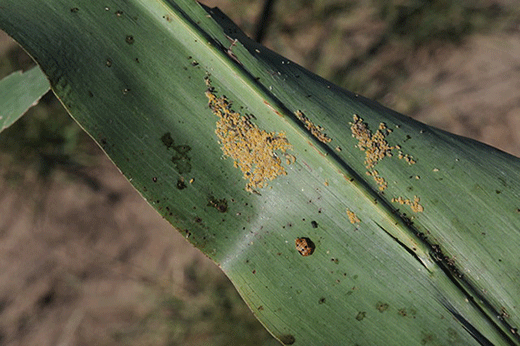
The sugarcane aphid is the most common of four aphids to cause damage to Kansas sorghum in recent years. The small insects suck liquid from the leaves and leave a sticky substance that attracts a harmful fungus. | Download this photo.
K-State crop entomologist advises patience when considering sorghum treatments
Whitworth says spraying for worms will also eliminate beneficial insects
August 9, 2019
MANHATTAN, Kan. – A crop entomologist at Kansas State University is urging sorghum growers to be patient as they consider options for protecting this year’s crop from damaging pests.
Jeff Whitworth says that using insecticides on sorghum can be a “balancing act” between choosing to treat for headworms or the sugarcane aphid – both of which can severely stunt the crop’s growth.
“If you treat for headworms, you’re going to decimate the beneficial insects” that may be in the field, Whitworth said.
“In other words, you’re also going to do a good job of killing all of the lady beetles, green lacewings, syrphid flies and other beneficials that might help provide control for the sugarcane aphid.”
He advised growers to check sorghum for headworms as soon as possible. If it’s obvious that there is an infestation, it will be important to treat those.
But, “if your sorghum hasn’t headed out yet and you don’t have headworms, there are some products that are very easy on beneficials if you’re spraying only for the sugarcane aphid,” Whitworth said.
He added that growers who treat headworm should get back out into the field in 1 to 2 weeks – according to instructions on the label of the product used – and check for colonies of aphids.
“You’re not going to get any help from the beneficial insects to control aphids, but at least then you can make a plan for what to do next,” he said.
Click Play to hear Jeff Whitworth talk about pests and sorghum:
The tiny sugarcane aphid has been the most common of four aphids to damage Kansas sorghum in recent years. The pest feeds on the plant, ravenously sucking liquid from its leaves and leaving a sticky substance that attracts a harmful fungus called black sooty mold.
Whitworth said sugarcane aphids tend to migrate into Kansas in late July to mid-August. They were especially troublesome in 2015 and 2016, but growers and scientists have since learned more on how to control their spread.
“The beneficial insects are great at finding these colonies of aphids,” Whitworth said. “In fact, when I go out looking for sugarcane aphid colonies, the first think I look for are swarms of syrphid flies or other beneficials because they will find the aphids before I do.”
As of early August, small infestations of sugarcane aphids were reported south of Highway 50 in Kansas. “As sorghum gets into the reproduction stages, get out and check your crop,” Whitworth said. “It can be very vulnerable at that time.”
Whitworth also has been keeping an eye on pests that may affect soybean fields this year.
“We’ve had really good growing conditions, so there is enough leaf matter in the soybean canopy that I don’t think (common pests) are going to cause a problem,” he said.
“As soybeans get into the reproductive stages, they can accept 20-30 percent defoliation and it’s not going to affect them, but you need to keep an eye on that because there is going to be another generation of webworms and yellow-striped armyworms and armyworms and other pests. So keep that in mind.”
Soybeans are also susceptible to the soybean aphid, which can establish if temperatures cool below 85 degrees Fahrenheit in the next few weeks.
“They migrate here every year on northern breezes,” Whitworth said. “It’s just a matter of whether it’s too hot for them to establish. The easiest way to find those is if you find ants crawling in the canopy. The ants are tending to the colony for the honeydew that the aphid produces.”
Whitworth’s guide for scouting sugarcane aphids is available online. More information on pests affecting Kansas crops is in the Kansas Insect Newsletter, published by K-State’s Department of Entomology.

